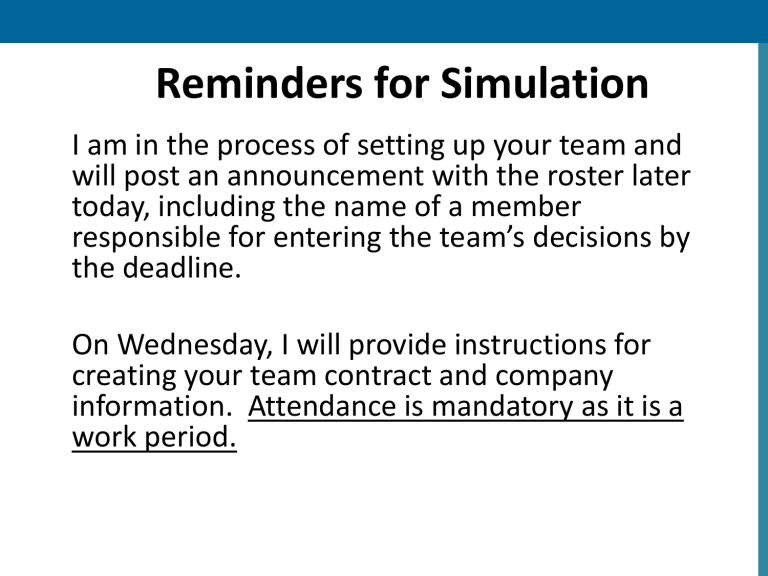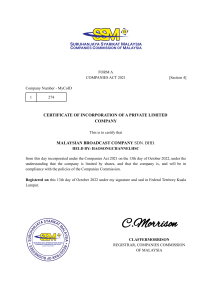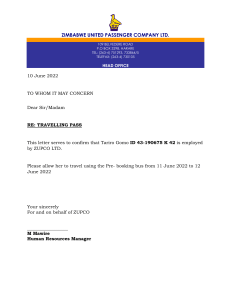
Reminders for Simulation I am in the process of setting up your team and will post an announcement with the roster later today, including the name of a member responsible for entering the team’s decisions by the deadline. On Wednesday, I will provide instructions for creating your team contract and company information. Attendance is mandatory as it is a work period. © 2022 McGraw Hill Ltd. Schwind 13th Edition 1-1 Reminders for Simulation Complete Quiz A by deadline and earn 2% of your course grade (access via simulation link) Individual Assignment. 2 attempts and highest score retained. © 2022 McGraw Hill Ltd. Schwind 13th Edition 1-2 Strategic Human Resource Management Chapter 1 © 2022 McGraw Hill Ltd. Schwind 13th Edition 1-3 1. Discuss the objectives of human resource management. 2. Identify steps in the strategic management of human resources. 3. Explain how human resource departments are organized and how they function. 4. Discuss the role of human resource professionals in today’s organization. © 2022 McGraw Hill Ltd. Schwind 13th Edition 1-4 HRM is the leadership and management of people within an organization using systems, methods, processes, and procedures that identify, select, motivate, and enable employees to achieve outcomes individually and collectively that enhance their contribution to the organization’s goals. HRM supports and enables organizations to: • Meet short and long-term economic, social, and environmental goals © 2022 McGraw Hill Ltd. Schwind 13th Edition 1-5 The Interconnectivity of Human Resource Management Activities Schwind 13th Edition, Figure 1-1 © 2022 McGraw Hill Ltd. Schwind 13th Edition 1-6 Strategic Human Resource Management • The process of integrating the strategic needs of an organization into the choice of HR systems and practices to support the overall mission, strategies, and performance • The choice of HR tools will depend on what the organization is trying to achieve • HR activities must align with and contribute to the organization’s strategies • Each HR practice should generate value for the organization © 2022 McGraw Hill Ltd. Schwind 13th Edition 1-7 A Model of Strategic HRM Five Steps 1. Organizational Mission, Goals, and Strategy Analysis 2. Environmental Scan 3. Analysis of Organizational Character and Culture 4. Choice and Implementation of Human Resource Strategies 5. Review, Education and Audit of Human Resource Strategies © 2022 McGraw Hill Ltd. Schwind 13th Edition, Figure 1-2 Schwind 13th Edition 1-8 Step 1: Organizational Mission, Goals, and Strategy Analysis Mission statement • Statement outlining the purpose, long-term objectives, and activities the organization will pursue and the course for the future • The organization’s goals outline what specifically the organization seeks to achieve in a given time period, which impacts its HR practices • The organization’s strategies determine the appropriate array of HR practices • HR strategies enable the successful completion of the organization’s strategies © 2022 McGraw Hill Ltd. Schwind 13th Edition 1-9 Step 2: Environmental Scan Continuous monitoring of economic, technological, demographic, and cultural forces The major forces: 1. 2. 3. 4. 5. Economic Technological Demographic Cultural Legal Schwind 13th Edition, Figure 1-3 © 2022 McGraw Hill Ltd. Schwind 13th Edition 1-10 Four Critical Economic Forces 1. 2. 3. 4. Economic cycles Global trade Productivity and innovation improvement Knowledge workers © 2022 McGraw Hill Ltd. Schwind 13th Edition 1-11 Economic Force: Economic Cycles Canadian economy goes through boom and bust cycles • Often linked to other economies During recessionary periods, HR faces challenges • Layoffs, wage concessions, lower morale During boom cycles, HR must consider • How to recruit and develop talent © 2022 McGraw Hill Ltd. Schwind 13th Edition 1-12 Economic Force: Global Trade • International trade has always been crucial to Canada’s prosperity and growth • Canada ranks high among exporting nations • Canadian jobs and economic prosperity depend upon international trade © 2022 McGraw Hill Ltd. Schwind 13th Edition 1-13 Economic Force: Global Trade Cont’d How Competitive is Canada Compared to Other Nations? Schwind 13th Edition, Figure 1-4 © 2022 McGraw Hill Ltd. Schwind 13th Edition 1-14 Economic Force: Productivity and Innovation Improvement • Productivity: Ratio of an organization’s outputs to its inputs • Productivity improvement is essential for long-term success • For over a decade, U.S. productivity has been consistently outpacing Canada • Without innovation, productivity differences tend to increase © 2022 McGraw Hill Ltd. Schwind 13th Edition 1-15 Economic Force: Knowledge Workers • Extractive industries (e.g., mining and fishing) have decreased • Industries relying on knowledge workers (e.g., education, health care, tourism, trade, public administration) have increased © 2022 McGraw Hill Ltd. Schwind 13th Edition 1-16 Three Critical Technological Forces 1. Connectivity and work design 2. Automation 3. Data and analytics © 2022 McGraw Hill Ltd. Schwind 13th Edition 1-17 Technological Force: Connectivity and Work Design Connectivity influences organizations and the way people work • Changed the way we work, play, study, and entertain ourselves • Access to information has affected the way organizations conduct business Technology has brought flexibility • When and where work is carried out (e.g., telecommuting) • Increased cybersecurity concerns © 2022 McGraw Hill Ltd. Schwind 13th Edition 1-18 Technological Force: Automation Organizations automate to: • • • • • Increase speed Provide better service Increase flexibility Increase predictability in operations Achieve higher standards of quality May use robots to replace boring or hazardous jobs © 2022 McGraw Hill Ltd. Schwind 13th Edition 1-19 Technological Force: Data and analytics • The role of data and analytics have shifted due to AI/ML and rapidly increasing computing power • Intranets and integrated information systems help store and access information quickly and accurately • Information management systems capturing digital information about employees give rise to human resource data analytics © 2022 McGraw Hill Ltd. Schwind 13th Edition 1-20 Four Critical Demographic Forces 1. 2. 3. 4. Gender balance Educational attainment of workers Aging population Generational shift © 2022 McGraw Hill Ltd. Schwind 13th Edition 1-21 Demographic Force: Gender Balance • 47% of the workforce assigned female at birth (2020) • Participation rate of biologically female in health care and professional, scientific, and technical services continues to grow • More women than men work part-time © 2022 McGraw Hill Ltd. Schwind 13th Edition 1-22 Demographic Force: Educational Attainment of Workers © 2022 McGraw Hill Ltd. Schwind 13th Edition, Figure 1-8 Schwind 13th Edition 1-23 Demographic Force: Aging Population Average age of the workforce is increasing • Impending “old age crisis” © 2022 McGraw Hill Ltd. Schwind 13th Edition, Figure 1-9 Schwind 13th Edition 1-24 Demographic Force: Generational Shift • Although the differences within groups may be wider than the differences between groups, some managers find benefit through understanding that not all generations view the world through the same lens that they do • Baby Boomers, Generation X, Generation Y (Millennials), and Generation Z and soon Generation Alpha, are all in the workforce • Different people have different expectations from their workplaces • Generational diversity creates an interpersonal dynamic for all leaders © 2022 McGraw Hill Ltd. Schwind 13th Edition 1-25 Two Critical Cultural Forces 1. Diversity and social justice 2. Ethics © 2022 McGraw Hill Ltd. Schwind 13th Edition 1-26 Cultural Force: Diversity and Social Justice • Canadian society is a cultural mosaic • Canada encourages maintaining unique culture and heritage vs. U.S. “melting pot” • Continued inequalities articulated by social justice advocates for Indigenous, Black, and other racialized people of colour attributed to systemic bias • Social justice has become central to diversity, equity, and inclusion initiatives in the workplace © 2022 McGraw Hill Ltd. Schwind 13th Edition 1-27 Cultural Force: Ethics • Ethical conduct of business is becoming an increasingly important issue • Managers should understand ethical perspectives and consider ethical implications © 2022 McGraw Hill Ltd. Schwind 13th Edition 1-28 Step 3: Analysis of Organizational Structure and Culture Human resource strategies should be formulated only after a careful look at the organization’s structure • Employees, objectives, technology, size, age, unions, policies, successes, failures Structure reflects the past and shapes the future Each organization has a unique culture • Core beliefs and assumptions that are widely shared by all organizational members © 2022 McGraw Hill Ltd. Schwind 13th Edition 1-29 Step 4: Choice and Implementation of Human Resource Strategies There should be a clear line of sight between HR strategy and corporate goals Schwind 13th Edition, Figure 1-10 © 2022 McGraw Hill Ltd. Schwind 13th Edition 1-30 Step 4: Choice and Implementation of Human Resource Strategies HR must continuously focus on the following activities: 1. Identifying opportunities, risks, and challenges 2. Making data-informed decisions aligned to strategy 3. Optimizing for high performance © 2022 McGraw Hill Ltd. Schwind 13th Edition 1-31 Step 5: Review, Evaluation, and Audit of Human Resource Strategies • • • HR Strategies should be examined periodically in consideration of changing factors (e.g., technology, environment) A holistic review of HR strategies with the intention of identifying and correcting deficiencies is called a human resource audit Human resource activities aimed at productivity improvement, succession planning, and cultural change are critical to competitive survival Schwind 12th Edition, Figure 1-12 © 2022 McGraw Hill Ltd. Schwind 13th Edition 1-32 The Organization of HRM HR Department in a small organization • Separate HR department emerges when HR activities becomes a burden • Often emerges as a small department or individual reporting to a middle-level manager © 2022 McGraw Hill Ltd. Schwind 13th Edition 1-33 The Human Resource Department in a Small Organization Schwind 13th Edition, Figure 1-12 © 2022 McGraw Hill Ltd. Schwind 13th Edition 1-34 The Organization of HRM Large HR Department • As the organization grows, the HR department usually grows in impact/complexity • Specialists are added • Vice President title © 2022 McGraw Hill Ltd. Schwind 13th Edition 1-35 A Large Human Resource Department Schwind 13th Edition, Figure 1-13 © 2022 McGraw Hill Ltd. Schwind 13th Edition 1-36 The Service Role of the HR Department Staff authority • • HR departments are service departments Authority to advise, not direct Line authority • Possessed by managers of operating departments (i.e., authority to make decisions) Functional authority • HR department may be provided authority to make decisions (e.g., deciding type of benefits) © 2022 McGraw Hill Ltd. Schwind 13th Edition 1-37 Today’s HR Professional Enormous growth in the number of HR managers • HR had been slow to evolve into a profession Competencies for HR Managers: • Strategy; engagement; labour and employee relations; learning and development; human resource metrics, reporting, and financial management; professional practice, workforce planning, and talent management; health, wellness, and safe workplaces; and total rewards The nationally recognized designation in HR is called the CPHR (Chartered Professional in Human Resources) for all Canadians except in Ontario, which has the Certified Human Resources Professional (CHRP) designation © 2022 McGraw Hill Ltd. Schwind 13th Edition 1-38 1 Strategic Human Resource Management Summary After mastering this chapter content, you should be able to: 1. Discuss the objectives of human resource management. 2. Identify steps in the strategic management of human resources. 3. Explain how human resource departments are organized and how they function. 4. Discuss the role of human resource professionals in today’s organization. © 2022 McGraw Hill Ltd. Schwind 13th Edition 1-39 Complete Chapter 1 Forum by Deadline Answer the following questions and label each answer as (a) and (b): a) List the typical goals of a human resource department. b) Choose an organization that you are familiar with and indicate which of these goals will be the most important and explain why. © 2022 McGraw Hill Ltd. Schwind 13th Edition 1-40








